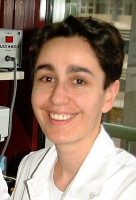2002 SwissTB Award
Maria Olleros
 The contribution of a transmembrane (tm) form of tumor necrosis factor (TNF) to protective immunity against Mycobacterium bovis BCG was studied in transgenic mice expressing a noncleavable transmembrane TNF but lacking the TNF-lymphotoxin-a (LT-a) locus (tm TNF tg mice). These mice were as resistant to BCG infection as wild-type mice, whereas TNF/LT-a -/-, TNF-/- and LT-a -/- mice succumbed. Tm TNF tg mice developed granulomas of smaller size but at 2-4 fold increased frequencies compared with wild-type mice. Granulomas were mainly formed by monocytes and activated macrophages expressing tm TNF mRNA and accumulating acid phosphatase. Nitric oxide synthase 2 (NOS2) activation as a key macrophage bactericidal mechanism, was low during the acute phase of infection in tm TNF tg mice, but still sufficient to limit bacterial growth and increased in late infection. IL-12 serum levels of tm TNF tg mice exceeded those of wild-type mice and IL-18 serum concentrations were similar to those of wild-type mice. Infection with virulent Mycobacterium tuberculosis resulted in very rapid death of TNF/LT-a -/- mice but survival of tm TNF tg mice which presented an increase in the number of CFU in spleen (5-fold) and lungs (10-fold) as compared to bacterial load of wild-type mice. In conclusion, the transmembrane form of TNF induces an efficient cell-mediated immunity and total resistance against BCG even in the absence of LT-a and secreted TNF. However, tm TNF mediated protection against virulent M. tuberculosis infection can also be efficient but not as strong as in BCG infection in which cognate cellular interactions may play a more predominant role in providing long-term surveillance and containment of BCG-infected macrophages.
The contribution of a transmembrane (tm) form of tumor necrosis factor (TNF) to protective immunity against Mycobacterium bovis BCG was studied in transgenic mice expressing a noncleavable transmembrane TNF but lacking the TNF-lymphotoxin-a (LT-a) locus (tm TNF tg mice). These mice were as resistant to BCG infection as wild-type mice, whereas TNF/LT-a -/-, TNF-/- and LT-a -/- mice succumbed. Tm TNF tg mice developed granulomas of smaller size but at 2-4 fold increased frequencies compared with wild-type mice. Granulomas were mainly formed by monocytes and activated macrophages expressing tm TNF mRNA and accumulating acid phosphatase. Nitric oxide synthase 2 (NOS2) activation as a key macrophage bactericidal mechanism, was low during the acute phase of infection in tm TNF tg mice, but still sufficient to limit bacterial growth and increased in late infection. IL-12 serum levels of tm TNF tg mice exceeded those of wild-type mice and IL-18 serum concentrations were similar to those of wild-type mice. Infection with virulent Mycobacterium tuberculosis resulted in very rapid death of TNF/LT-a -/- mice but survival of tm TNF tg mice which presented an increase in the number of CFU in spleen (5-fold) and lungs (10-fold) as compared to bacterial load of wild-type mice. In conclusion, the transmembrane form of TNF induces an efficient cell-mediated immunity and total resistance against BCG even in the absence of LT-a and secreted TNF. However, tm TNF mediated protection against virulent M. tuberculosis infection can also be efficient but not as strong as in BCG infection in which cognate cellular interactions may play a more predominant role in providing long-term surveillance and containment of BCG-infected macrophages.
Publication
Transmembrane TNF induces an efficient cell-mediated immunity and resistance to Mycobacterium bovis BCG infection in the absence of secreted TNF and LT-a1
Maria L. Olleros*, Reto Guler*, Nadia Corazza† , Dominique Vesin*, Hans-Pietro Eugster‡, Gilles Marchal+, Pierre Chavarot+, Christoph Mueller†, and Irene Garcia2*
*Department of Pathology, University of Geneva ; †Department of Pathology, University of Bern ; ‡Department of Internal Medicine, University Hospital Zurich, Switzerland; and +Laboratoire du BCG and Unité de Physiopathologie de l’Infection, Institut Pasteur, Paris, France
1This work was supported by Grants 3200-054401.98 and 3200-062026.00 (to I.G.) and 31-53961.98 (to C.M.) from the Swiss National Foundation for Scientific Research and from Roche and Novartis Foundations.
